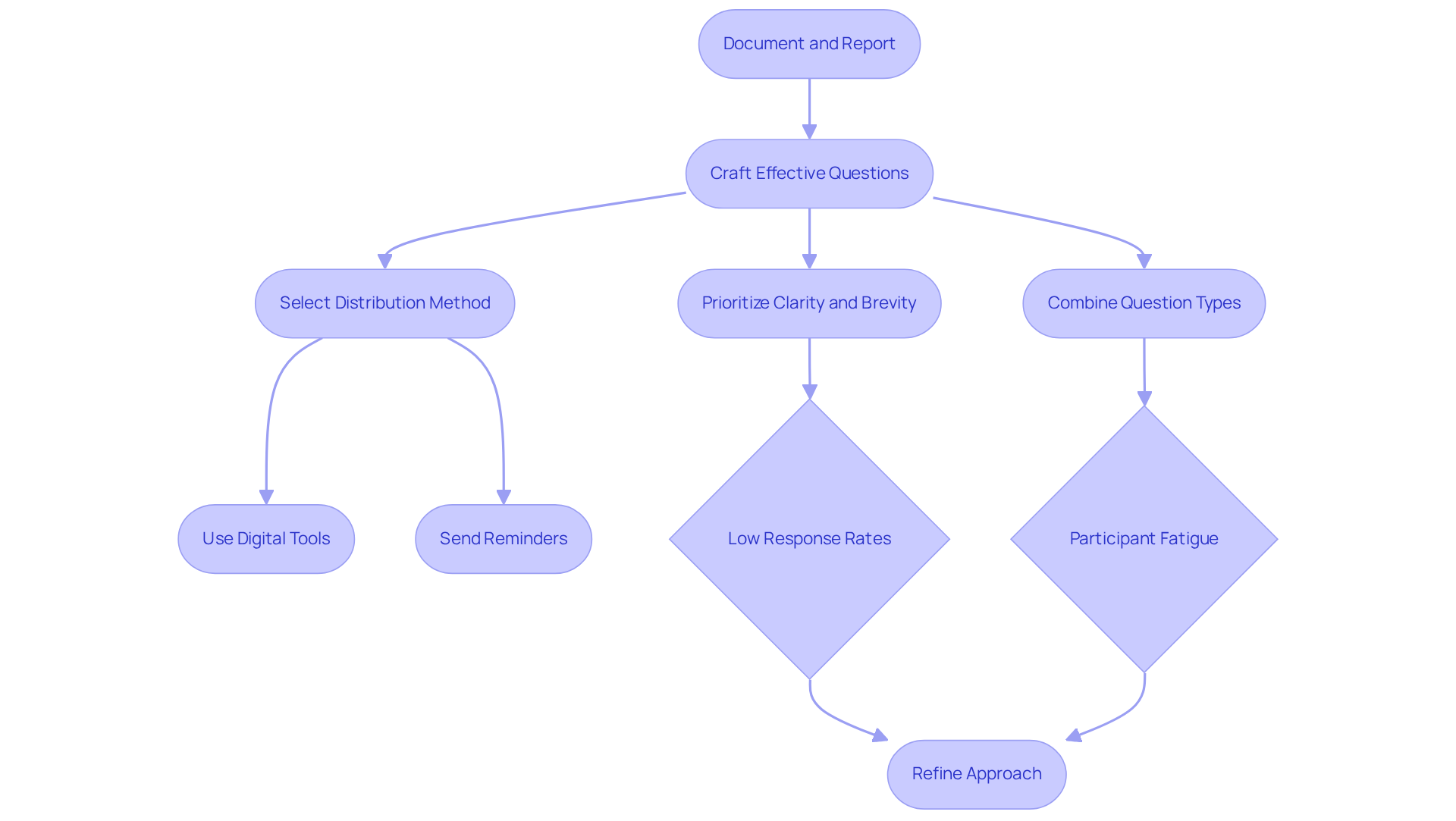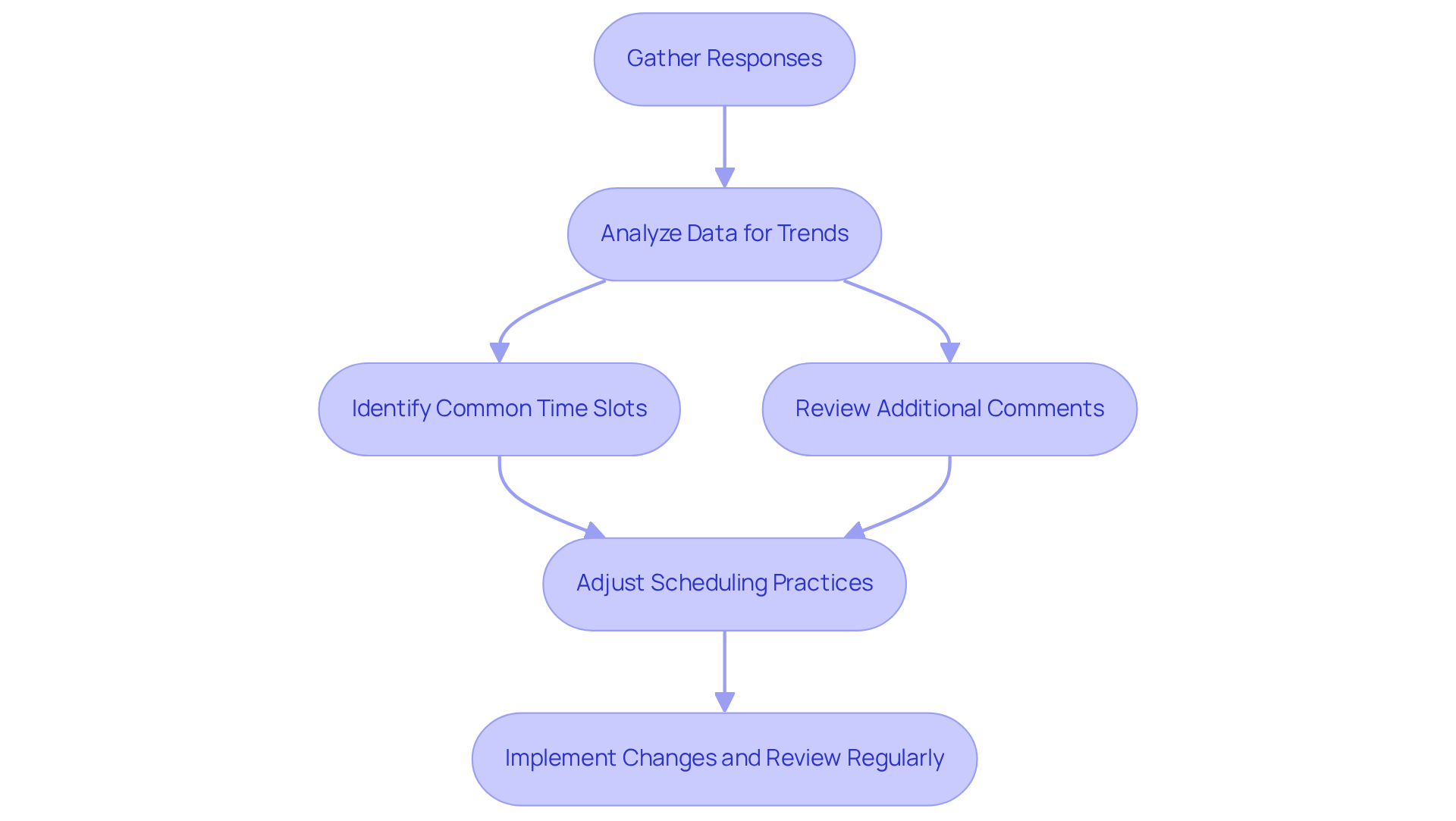3 Best Practices for Your Meeting Time Survey Success

Overview
In today’s fast-paced business environment, communication inefficiencies can severely hinder operational success. Organizations often struggle with meeting attendance and productivity, leading to wasted time and resources. To combat these challenges, it’s essential to adopt effective strategies that enhance engagement and streamline processes.
One of the most effective practices is defining clear objectives for your meeting time surveys. By establishing specific goals, organizations can focus their efforts and ensure that every meeting serves a purpose. This clarity not only guides the planning process but also sets expectations for participants, ultimately leading to higher attendance rates.
Next, crafting effective questions is crucial. Well-structured questions can elicit valuable insights from participants, allowing organizations to gather relevant data that informs scheduling decisions. This targeted approach ensures that the right people are in the room, fostering a more productive environment.
Finally, analyzing responses thoroughly is key to optimizing scheduling. By examining the gathered data, organizations can identify patterns and preferences that enhance future meeting planning. Evidence shows that organizations that implement these strategies see significant improvements in attendance and productivity, demonstrating the power of a data-driven approach.
In conclusion, by defining clear objectives, crafting effective questions, and analyzing responses, organizations can transform their meeting strategies. Embrace these best practices to not only enhance attendance but also drive productivity, ensuring that every meeting counts.
Introduction
Crafting an effective meeting time survey is crucial for enhancing collaboration and productivity within teams. Communication inefficiencies can hinder operational success, with studies showing that only a fraction of meetings are deemed productive. By strategically defining objectives and employing best practices in question formulation and distribution, organizations can gather invaluable insights into their members’ preferences. This approach not only aligns scheduling with collective needs but also avoids common pitfalls that often derail team engagement.
Imagine a scenario where every team member feels their voice is heard, leading to increased attendance and participation. By implementing these surveys, teams can transform their meeting culture, ensuring that every gathering is purposeful and productive. This article delves into three essential practices that can turn meeting time surveys into powerful tools for optimizing engagement and attendance.
In conclusion, the right strategies can revolutionize how teams approach meetings, making them more effective and aligned with members’ needs. Explore these practices further to unlock the full potential of your team’s collaboration.
Define Objectives for Your Meeting Time Survey
Establishing clear goals before launching your survey is crucial for success. What do you want to achieve? Are you looking to pinpoint the most convenient meeting times for your team through a meeting time survey, or are you trying to understand preferences for meeting formats, like in-person versus virtual? By clarifying these objectives, you can tailor your questions to gather the most relevant data. For instance, if your goal is to boost attendance, focus on a meeting time survey to identify time slots that work for the majority. This targeted approach streamlines the assessment process and significantly enhances the likelihood of actionable results that meet your team’s needs.
Research indicates that organizations with clear objectives see improved outcomes. This reinforces the idea that a goal without a plan is merely a wish, as Antoine de Saint-Exupéry wisely noted. As Tony Robbins aptly stated, “Setting goals is the first step in turning the invisible into the visible.” By establishing clear goals, you not only guide the project’s direction but also empower your team to engage meaningfully with the findings. Incorporating strategies from successful case studies, such as those highlighted in the “Tips for Achieving Goals” section, can further demonstrate the effectiveness of this approach.

Craft Effective Questions and Distribute Your Survey
To tackle the challenges of communication inefficiencies in gathering feedback, it’s essential to prioritize clarity and brevity in your survey questions. A balanced approach that combines multiple-choice and open-ended questions not only captures quantitative data but also provides valuable qualitative insights. For instance, you might ask, “What days of the week are you most free for discussions?” followed by an open-ended prompt like, “Please share any additional preferences or constraints regarding meeting times.” This method ensures you gather comprehensive feedback that truly reflects your team’s needs.
Once your questions are refined, selecting the right distribution method becomes crucial. Leverage digital tools that seamlessly integrate with your existing communication platforms, such as Qualtrics or REDCap, which meet WSU standards for data collection software. This integration simplifies access for participants, encouraging them to engage and complete the questionnaire. Additionally, sending reminders can significantly boost participation rates, enabling you to collect a robust set of responses that accurately represent your team’s preferences.
Be aware of common pitfalls in questionnaire distribution, such as low response rates and participant fatigue, which often stem from ineffective sampling. Opting for a sample rather than a census can mitigate these issues, ensuring that your results are both reliable and actionable. Lastly, maintaining clear documentation and reporting throughout the survey process is vital for transparency and future reference, reinforcing the credibility of your findings.

Analyze Responses to Optimize Meeting Scheduling
Once you’ve gathered responses, the next crucial step is to analyze the data to pinpoint trends and preferences. Identify common time slots that receive the most votes in the meeting time survey, and pay attention to any additional comments for insights into specific needs or constraints. Utilizing tools like spreadsheets or survey analysis software can significantly enhance your ability to visualize the data, making it easier to spot patterns.
According to the case study “Creating Data Tables for Clarity,” effective use of data tables can greatly improve the presentation of numerical data, facilitating clearer communication of findings. Based on your analysis, adjust your scheduling practices accordingly. For instance, if the majority favors gatherings on Tuesday afternoons, prioritize that slot for upcoming meetings. Regularly reviewing and refining your scheduling methods based on feedback from a meeting time survey can lead to improved attendance and engagement over time.
As Emily Helen Arnold notes, pulse surveys provide real-time insights into employee sentiment, allowing organizations to swiftly address emerging issues. This iterative approach not only aligns schedules with employee preferences but also fosters a culture of responsiveness and adaptability within the organization. Given that only 30% of meetings are considered productive, optimizing scheduling practices is essential for enhancing overall meeting effectiveness.

Conclusion
Establishing effective meeting time surveys is crucial for fostering collaboration and maximizing productivity within teams. By clearly defining objectives, crafting precise questions, and thoroughly analyzing responses, organizations can ensure that their meetings are scheduled at times that work best for all participants. This strategic approach not only enhances attendance but also cultivates a more engaged and responsive workplace culture.
The article emphasizes three best practices:
- Setting clear goals to guide the survey process
- Developing effective questions that capture both quantitative and qualitative feedback
- Analyzing the collected data to optimize scheduling
Each of these steps plays a critical role in ensuring that the survey yields actionable insights, ultimately leading to improved meeting effectiveness and team satisfaction.
As organizations navigate the complexities of remote and hybrid work environments, prioritizing the optimization of meeting schedules based on survey data is more important than ever. By implementing these best practices, teams can create a more inclusive and productive atmosphere that respects individual preferences and promotes collaboration. Embracing this approach will not only enhance the quality of meetings but also contribute to a more dynamic and engaged workforce.
Frequently Asked Questions
Why is it important to define objectives before conducting a meeting time survey?
Defining clear objectives is crucial for the success of a meeting time survey as it helps determine what you want to achieve, such as identifying convenient meeting times or understanding preferences for meeting formats. This clarity allows you to tailor your questions to gather the most relevant data.
What should I focus on if my goal is to boost attendance for meetings?
If your goal is to boost attendance, you should focus on conducting a meeting time survey to identify time slots that work for the majority of your team. This targeted approach enhances the likelihood of actionable results.
How do clear objectives impact the outcomes of a survey?
Research indicates that organizations with clear objectives see improved outcomes. Having defined goals guides the project’s direction and empowers the team to engage meaningfully with the findings.
What can I learn from successful case studies when defining objectives for a survey?
Incorporating strategies from successful case studies can demonstrate the effectiveness of your approach to defining objectives and conducting surveys, as highlighted in the ‘Tips for Achieving Goals’ section.
